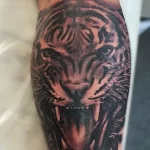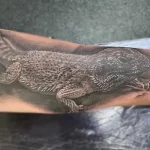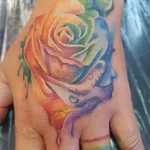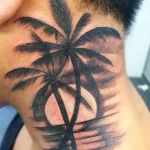Tattoo FAQ's
Modify Tattoo and Piercing
Getting a tattoo is a big decision, and it’s natural to have questions. Whether you’re curious about the pain, cost, aftercare, or how to choose the right design, this tattoo FAQ's page has you covered. We’ve gathered answers to the most common tattoo questions to help you feel confident and informed before your next session.
Tattoo FAQ's How Much Does a Tattoo Cost?
How Much Does a Tattoo Cost?
Tattoo pricing depends on several factors. Size, design complexity, and placement all play a significant role in determining the cost.
Factors Influencing Tattoo Pricing
Artists usually charge by the hour. Rates can range from $100 to $250 per hour, depending on the artist's skill and experience. Our current rate is $170 per hour. Our shop minimum is $140, while larger or intricate tattoos can go up to thousands.
Design Complexity and Customization
Custom designs often come with a higher price tag. Artists spend extra time creating unique artwork, and detailed designs typically take longer to complete.
Shop Location and Reputation
Tattoo prices may also vary based on the studio’s location. High-demand areas like big cities usually have more expensive shops. Additionally, well-known artists or shops with solid reputations may charge more for their services.
Additional Costs to Consider
Aftercare products, touch-ups, and tips are additional expenses to factor in. High-quality aftercare ensures your tattoo heals properly, and tipping your artist is customary for great service.
Tattoo FAQ's Do Tattoos Hurt?
Tattoo pain is a common concern.
The level of discomfort depends on various factors, including individual pain tolerance and the location of the tattoo.
Pain Levels Based on Tattoo Location
Some areas of the body are more sensitive than others. Places with less flesh, like ribs, ankles, or fingers, tend to hurt more. Conversely, areas with more fat or muscle, such as the upper arm or thigh, are usually less painful.
Individual Pain Tolerance
Everyone experiences pain differently. What might be uncomfortable for one person could be tolerable for another. If you're worried, talk to your artist about how to manage discomfort.
Tips for Managing Tattoo Pain
Preparing for your session can make a difference. Stay hydrated, avoid alcohol, and get a good night's sleep before getting tattooed. Taking breaks during the session and practicing deep breathing can also help.
Tattoo FAQ's What to Consider When Choosing Your First Tattoo
Considerations
Getting your first tattoo is exciting, but it's important to think carefully before making your decision. Consider design, placement, and the artist to ensure you're happy with the result.
Meaning Behind the Tattoo
Your first tattoo will likely have special significance. Choose a design that holds personal meaning or represents something important to you. Whether it's a tribute, a favorite symbol, or a piece of art, make sure it resonates with you.
Tattoo Placement
The location of your tattoo can affect how often you see it and how much it hurts to get. Popular spots for first tattoos include the forearm, upper arm, or calf. Avoid highly sensitive areas like ribs or spine unless you're prepared for extra pain.
Choosing the Right Tattoo Artist
Research is key when selecting an artist. Look at portfolios and check reviews to ensure they specialize in the style you want. A skilled artist will guide you through the process, from design to aftercare.
Tattoo Size and Visibility
Start with a smaller design if you're uncertain. It's easier to manage for a first experience and gives you a feel for the process. Also, consider whether you want the tattoo to be visible in everyday situations.
Long-Term Commitment
Tattoos are permanent, so think about how your chosen design may look in the future. Trends change, but classic designs or ones with personal meaning tend to stand the test of time.
Tattoo FAQ's Is It Okay to Ask to See an Artist's Portfolio?
Absolutely.
It's encouraged. Asking to see a tattoo artist's portfolio is a normal part of the process and helps ensure you're choosing the right person for your design.
Why a Portfolio Is Important
A portfolio showcases the artist's work and style. It gives you an idea of their experience, quality, and whether their artistic approach matches your vision.
How to Ask for a Portfolio
Politely ask the artist or studio to show you their portfolio. Most professional artists have a collection of their best work readily available, either online or in the studio.
What to Look for in a Portfolio
Pay attention to clean lines, color saturation, and overall execution. If you're looking for a specific style—such as realism, traditional, or blackwork—check that the artist has experience in that area.
Building Trust with Your Artist
Reviewing a portfolio helps build confidence in your choice. It also opens a dialogue with the artist, allowing you to discuss your ideas and ensure you're both on the same page.
Tattoo FAQ's Is It OK to Get a Tattoo if I'm Sick?
It's generally not recommended.
getting a tattoo when you're feeling unwell. Your body needs to be in good health to handle the process and heal properly.
Impact on the Immune System
When you're sick, your immune system is already working hard to fight off illness. Getting a tattoo while sick can slow down the healing process and make you more susceptible to infections.
Risk of Spreading Illness
If you have a contagious illness, such as a cold or flu, visiting a tattoo studio can put others at risk. It's best to reschedule your appointment until you're feeling better.
How Sickness Affects Pain Tolerance
Being unwell can lower your pain tolerance, making the tattooing process more uncomfortable. It's better to wait until you're in top condition to ensure a smoother experience.
Better Results When You're Healthy
Tattoo healing relies on your body's ability to repair the skin. When you're healthy, the healing process is faster, and the results are likely to be better.
Tattoo FAQ's My friend just bought at tattoo kit and wants to practice on me
Do not let them do it.
While it might seem exciting to help a friend practice, there are several serious considerations before allowing someone without professional experience to tattoo you.
Health and Safety Risks
Tattooing involves piercing the skin with needles, which means there's a risk of infection, especially if proper sterilization techniques aren't followed. Professional tattoo artists go through extensive training to ensure safe practices. Using unsterilized equipment or working in an unclean environment can lead to infections, scarring, and bloodborne diseases.
Lack of Experience and Technique
Tattooing requires precision and experience. Even with the best intentions, a beginner might not have the skills to give you a clean, professional-looking tattoo. Mistakes made during the process could leave you with poor-quality work or permanent damage to your skin.
Long-Term Consequences
Tattoos are permanent, and removing or fixing poorly done tattoos can be painful and costly. Laser removal is an option, but it's a lengthy and expensive process that isn't guaranteed to fully erase a tattoo.
Alternative Suggestions
Encourage your friend to practice on synthetic skin or fruit like oranges or grapefruits, which are common alternatives for beginners. If they're serious about tattooing, suggest they look into apprenticeships with a professional artist to properly learn the craft.





